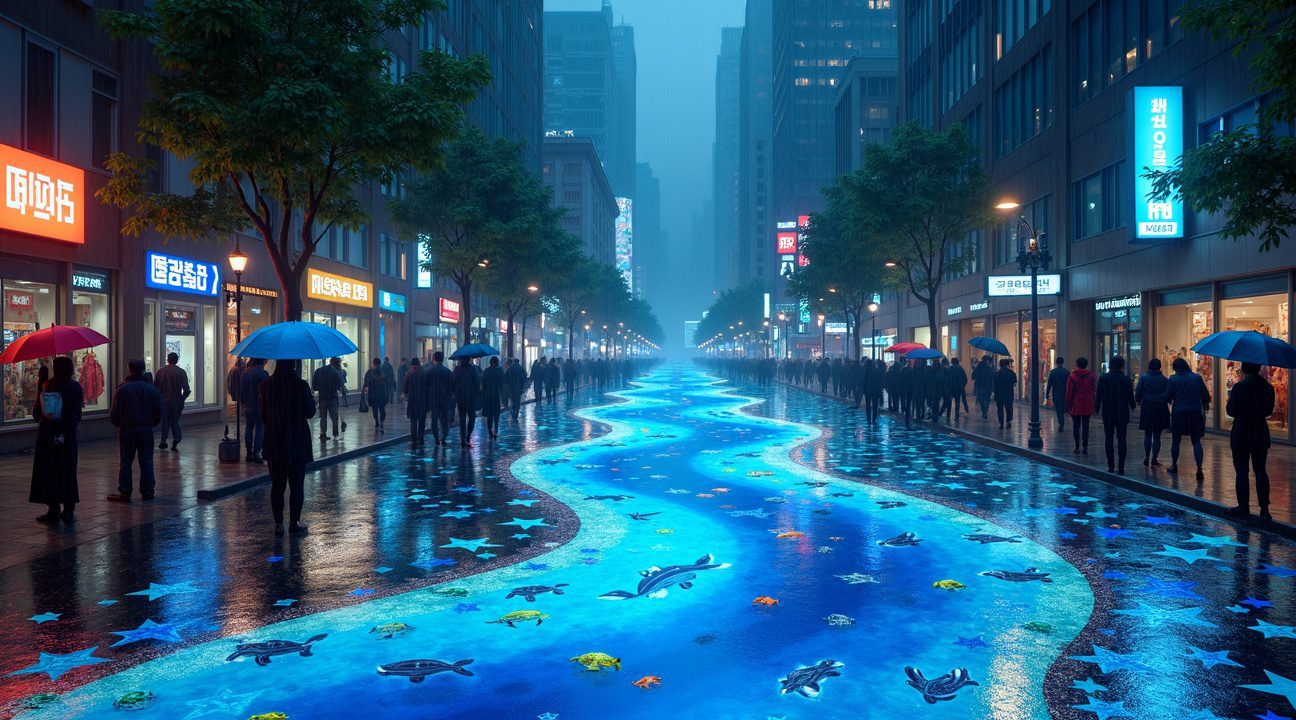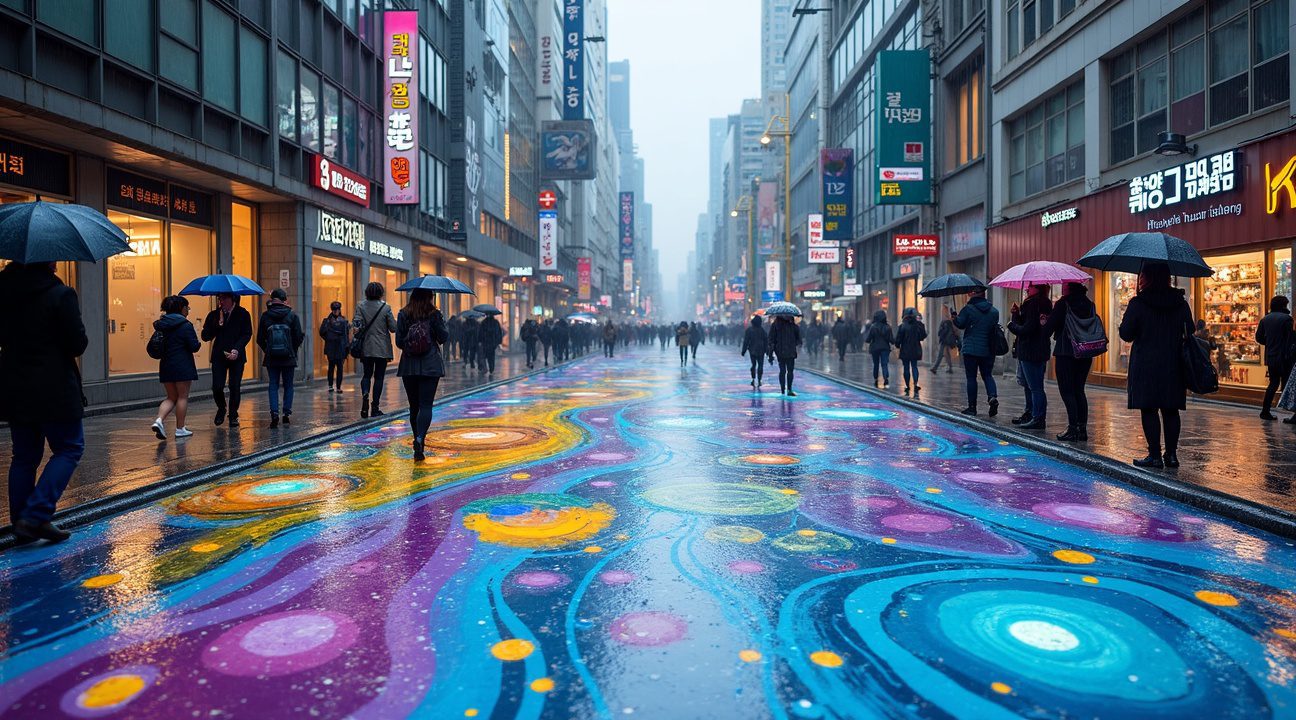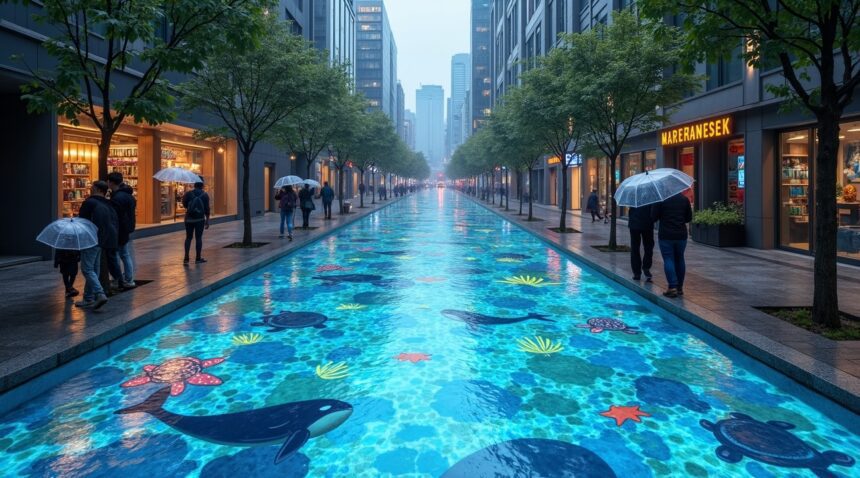Project Monsoon represents a groundbreaking concept that transforms Seoul’s rainy streets into hidden art galleries through hydrochromic paint technology that reveals vibrant marine-themed murals only when rainwater activates the specially treated surfaces.
Key Takeaways
- Hydrochromic paint technology enables invisible street art that appears only when exposed to water, creating temporary murals during rainfall that disappear when surfaces dry.
- Project Monsoon earned prestigious design awards, including the D&AD Black Pencil and Yellow Pencil Awards, for its innovative concept, despite never being physically installed in Seoul.
- The project went viral globally through major media outlets and social media platforms, demonstrating how compelling design concepts can achieve widespread cultural impact without real-world implementation.
- Weather-responsive art installations are inspiring cities worldwide to explore interactive public art that transforms routine weather events into opportunities for community engagement and urban discovery.
- The concept challenges traditional urban planning by reframing rain from an inconvenience into a catalyst for beauty, encouraging cities to work with natural elements rather than against them.
When Seoul’s Streets Come Alive: Murals That Only Exist in the Rain
Project Monsoon transformed Seoul’s relationship with rain through an innovative street art concept that literally brings color to gray days. Designers Seunghoon Shin, Yoonshin Kim, and Nu Ri Kim partnered with Pantone and the School of the Art Institute of Chicago to develop this groundbreaking approach to urban art.
The Magic of Hydrochromic Paint Technology
The secret behind this enchanting street art lies in hydrochromic paint, a specialized coating that remains completely transparent when dry but transforms into vibrant colors when exposed to water. This remarkable material allowed the designers to create invisible murals that would only reveal themselves during Seoul’s frequent rainstorms. Since Seoul experiences rain for up to three weeks during monsoon season, the timing couldn’t be more perfect for this type of weather-activated art installation.
When raindrops hit the treated surfaces, the streets literally come alive with marine-themed imagery. Fish, turtles, and whales emerge from what appeared to be ordinary pavement just moments before. I find this concept particularly brilliant because it transforms the city’s wettest season from a dreary inconvenience into moments of genuine wonder and discovery.
Turning Streets Into Underwater Worlds
The artistic vision behind Project Monsoon goes beyond simple novelty. As rain cascades down Seoul’s streets, the hydrochromic paint creates the illusion that the urban landscape has transformed into a flowing river teeming with aquatic life. This conceptual approach addresses the psychological impact of Seoul’s extended rainy periods, offering residents and visitors unexpected bursts of color and whimsy during traditionally gloomy weather.
The marine life themes weren’t chosen randomly either. Fish and turtle motifs create a cohesive underwater narrative that flows naturally with the water running down streets and sidewalks. Travel enthusiasts visiting Seoul during monsoon season would experience something completely unique – street art that exists only in specific weather conditions.
What makes this concept particularly ingenious is how it reframes people’s relationship with rain. Instead of rushing indoors or hiding under umbrellas, pedestrians might find themselves slowing down to appreciate the temporary art gallery that has materialized beneath their feet. The project demonstrates how thoughtful design can transform urban challenges into opportunities for beauty and surprise, making Seoul’s rainy season something to anticipate rather than endure.

The Magic Behind Hydrochromic Paint Technology
Hydrochromic paint operates as a smart material specifically engineered for interactive experiences. This innovative coating remains completely invisible when dry, creating an element of mystery on Seoul’s sidewalks and building walls. Only when water makes contact with the painted surface does the magic begin—the paint transforms from transparent to opaque, revealing brilliant colors that would otherwise remain hidden from passersby.
The technology behind this transformation relies on specialized pigments that react to moisture molecules. When raindrops hit the treated surfaces, the paint’s molecular structure changes, allowing previously concealed artwork to emerge in stunning detail. Artists can create elaborate designs that lie dormant during dry weather, waiting for the next downpour to bring their creations to life.
Environmental Context Meets Creative Design
Rain-activated street art represents a perfect fusion of environmental factors and artistic vision. South Korea’s monsoon seasons, which many residents view as inconvenient, become opportunities for urban discovery. I’ve observed how this approach transforms the typical relationship between weather and mood—what was once considered gloomy becomes a catalyst for wonder and exploration.
This weather-responsive art form challenges traditional concepts of permanence in public installations. Creative innovations like these demonstrate how artists can work with natural elements rather than against them. The temporary nature of the reveals adds urgency to the viewing experience, encouraging people to venture outside during storms to witness the hidden artwork.
Inspiring Future Urban Installations
These responsive murals serve as blueprints for future city planning initiatives worldwide. Urban planners and artists now recognize the potential for weather-reactive installations that can transform dreary streetscapes into dynamic galleries. Unlike traditional static public art, these installations respond to environmental conditions, creating ever-changing urban landscapes.
The development of water-reactive public art continues to advance, with artists experimenting with different trigger mechanisms and color-changing technologies. Some installations now respond to varying levels of moisture, creating gradient effects as rainfall intensity changes. Others incorporate multiple layers of hydrochromic paint, revealing different images as water exposure increases.
Cities looking to implement similar projects can learn from South Korea’s approach to integrating technology with public art. Urban exploration takes on new meaning when hidden artworks await discovery around every corner. This innovative use of hydrochromic technology proves that interactive public art can enhance community engagement while transforming ordinary infrastructure into extraordinary experiences.
Korean Cultural Symbolism Meets Modern Innovation
South Korea’s hidden rain art transforms streets into dynamic canvases that celebrate the nation’s profound connection to water through centuries-old cultural traditions. The project brilliantly weaves Korean symbolism into contemporary urban design, creating spaces where ancient reverence for rivers and flowing water meets cutting-edge artistic innovation.
Water as Life Force in Korean Heritage
Rivers hold sacred significance in Korean culture, representing the flow of life, prosperity, and spiritual cleansing. These hidden murals honor this tradition by depicting flowing waterways that mirror Korea’s mountainous landscape and seasonal rhythms. I find these installations particularly striking because they transform mundane sidewalks into representations of Korea’s natural beauty, where water becomes both the medium and the message.
The marine life themes embedded throughout these artworks reflect Korea’s peninsular geography and its people’s deep relationship with both rivers and seas. Fish, waves, and aquatic plants emerge from gray pavement when rain activates the special pigments, creating scenes that could have been lifted from traditional Korean paintings. This connection between street style and cultural heritage demonstrates how modern cities can honor their past while embracing innovation.
Reimagining Urban Spaces Through Interactive Art
These installations fundamentally challenge how people experience city environments by making streets responsive to weather patterns. The concept encourages pedestrians to view rain differently—not as something that disrupts daily life but as nature’s paintbrush revealing hidden beauty. When precipitation hits the pavement, vibrant blues, greens, and earth tones spread across surfaces like digital magic, though the technology relies on hydro-chromatic materials rather than electronics.
The transformative nature of these artworks mirrors Korea’s seasonal cycles, where landscapes shift dramatically throughout the year. During dry periods, the streets appear ordinary, maintaining their practical function. However, rain triggers spectacular displays that can turn a simple walk into an unexpected adventure, much like how solo travel can reveal surprising discoveries.
Artists behind these projects deliberately chose water motifs to create continuity between Korea’s artistic heritage and its urban future. Traditional Korean ink paintings often featured flowing rivers and cascading waterfalls, using minimal brushstrokes to capture water’s essence. These street murals apply similar aesthetic principles, allowing rain to complete the artwork just as traditional painters left space for viewers’ imagination.
The innovation extends beyond mere visual appeal. These installations encourage community engagement by creating shared experiences around weather events. Families venture out during light rain to witness the transformations, while photographers document the ephemeral art before it fades. This social aspect reflects Korean culture’s emphasis on collective experiences and seasonal celebrations.
Local governments have embraced these projects as tools for urban revitalization, recognizing how they can transform neglected spaces into destinations. The temporary nature of the displays adds urgency and excitement, making each rainfall an event worth experiencing. Unlike permanent murals that people eventually ignore, these hidden artworks maintain their ability to surprise and delight.
The marine life imagery specifically connects to Korea’s coastal traditions and fishing heritage. Octopi, schools of fish, and flowing seaweed patterns emerge during rainfall, creating underwater worlds on city streets. These designs honor the country’s relationship with the ocean while making urban environments more playful and imaginative.
Rain-activated art also addresses practical concerns about urban aesthetics during Korea’s lengthy monsoon seasons. Instead of viewing wet weather as dreary, these installations reframe precipitation as an opportunity for beauty and wonder. The approach demonstrates how thoughtful design can improve quality of life by finding joy in everyday circumstances, much like how summer accessories can transform ordinary outfits into memorable looks.
Viral Fame vs. Street Reality: The Truth About Project Monsoon
I need to address a fascinating disconnect between internet fame and actual reality. Project Monsoon, despite its widespread coverage as a revolutionary street art installation in Seoul, was never actually implemented on the city’s streets.
The truth contradicts what countless articles and social media posts have claimed. No Seoul residents have documented encounters with these rain-activated murals through personal photos or local testimonials. Local Korean publications haven’t covered the installation as an existing public art feature. The compelling images that circulated globally originated from promotional materials created by the design team, not from actual street installations.
This revelation becomes even more intriguing when considering the project’s remarkable success in design circles. Project Monsoon earned prestigious recognition, including the D&AD Black Pencil and Yellow Pencil Awards. These accolades represent some of the highest honors in the creative industry, typically reserved for groundbreaking work that pushes creative boundaries.
When Concept Meets Global Recognition
The awards highlight an important distinction in creative industries between conceptual brilliance and physical implementation. Design competitions often celebrate innovative thinking and creative problem-solving, regardless of whether projects reach actual construction or installation phases. Project Monsoon exemplified this perfectly — a concept so compelling that it earned international acclaim purely on its creative merit.
Several factors contributed to the project’s viral spread across design media and general interest publications:
- The concept’s inherent visual appeal and Instagram-worthy potential
- Seoul’s reputation as a forward-thinking city embracing creative urban interventions
- The romantic notion of hidden art revealed by natural elements
- Professional-quality renderings that appeared authentic to casual observers
- The story’s perfect blend of technology, art, and environmental interaction
This phenomenon reflects how creative concepts can capture imaginations and spread rapidly through digital media. The project’s reach extended far beyond design publications, appearing in travel blogs, social media feeds, and general interest articles worldwide.
The gap between Project Monsoon’s reputation and reality illuminates modern media consumption patterns. Many publications republished the story without ground-level verification, relying on compelling visuals and the project’s design award credentials. This created a feedback loop where each new article reinforced the project’s perceived authenticity.
Seoul continues to embrace actual innovative public art installations, making the city a natural backdrop for such a concept. The urban environment’s existing creativity made Project Monsoon’s story believable to international audiences unfamiliar with Seoul’s specific art landscape.
Understanding this distinction doesn’t diminish the project’s creative value. Conceptual work plays a crucial role in advancing design thinking and inspiring future implementations. Project Monsoon succeeded in sparking global conversations about interactive public art, environmental responsiveness, and creative urban interventions.
The project demonstrates how powerful storytelling and visual communication can transcend physical limitations. While people can’t experience these rain-activated murals firsthand in Seoul, the concept has influenced discussions about public space, technology integration, and creative placemaking worldwide.
This case study serves as a reminder for travelers and urban explorers to verify claims about specific installations before planning visits. Social media’s visual nature often prioritizes compelling content over factual accuracy, creating situations where beautiful concepts overshadow practical realities.
Project Monsoon’s legacy lies not in Seoul’s streets but in its demonstration of how innovative design thinking can capture global attention and inspire future creative work, even without physical manifestation.
https://www.youtube.com/watch?v=zF-3nZYtx00
Global Impact of a Concept That Never Was
Project Monsoon captured international attention despite never being physically implemented on South Korean streets. Major media outlets including The Independent, My Modern Met, Mic, and Bored Panda featured the innovative concept, amplifying its reach across global audiences. The hashtag #ProjectMonsoon gained significant traction on social media platforms, demonstrating how creative ideas can spread rapidly in today’s connected world.
The project’s online presence remains robust, though no actual street photographs exist beyond the carefully crafted media campaigns shared by the original design team. This absence of real-world implementation hasn’t diminished its cultural impact. Instead, the concept has sparked meaningful conversations about the future of public art and urban creativity. Many cities now explore similar interactive installations, drawing inspiration from what Project Monsoon could have achieved.
Inspiring Innovation Across Continents
The widespread fascination with rain-activated street art has influenced public art communities globally. Artists and urban planners reference Project Monsoon when discussing creative street style and innovative approaches to city beautification. Several key impacts have emerged from this conceptual project:
- Increased funding proposals for interactive public art installations in major cities
- Academic discussions about technology integration in urban environments
- Enhanced public interest in weather-responsive artistic applications
- Growing support for experimental art initiatives that engage with natural elements
The project demonstrates how imaginative design concepts can provoke widespread interest and meaningful dialogue without requiring physical construction. Cities from London to Tokyo have referenced Project Monsoon in their own public art proposals, suggesting its influence extends far beyond South Korea’s borders. Art schools now teach the concept as a case study in viral marketing and conceptual design success.
Public art advocates continue citing Project Monsoon as evidence that innovative thinking can reshape how communities interact with their urban environments. The project’s legacy proves that sometimes the most powerful art exists in the imagination, inspiring countless others to push creative boundaries. Design teams worldwide now understand that compelling concepts can generate significant cultural impact through digital storytelling and strategic media engagement, even when travel destinations don’t feature the actual installations.

How Rain-Activated Art Could Transform Cities Worldwide
Project Monsoon’s unfulfilled promise in Seoul continues to spark innovative thinking about weather-responsive urban design across the globe. Artists and city planners increasingly recognize the potential for transforming mundane weather events into extraordinary public experiences that bring communities together.
The technology behind these installations centers on hydrochromic materials that react to moisture, revealing hidden images and patterns when water touches their surface. These specialized pigments and coatings have become more affordable and accessible, opening doors for widespread implementation in urban settings. Major cities now experiment with similar concepts, creating installations that respond to rain, snow, and even humidity changes.
Rain-activated murals represent just one element of a larger shift in urban planning philosophy. Modern cities embrace smart design principles that integrate responsive technologies into everyday infrastructure. Street art that appears during rainfall transforms ordinary commutes into unexpected discoveries, creating moments of wonder in otherwise routine experiences.
Practical Applications for Future Cities
Urban planners can incorporate weather-responsive art into various city elements to maximize community engagement:
- Crosswalks that reveal safety messages or decorative patterns during wet conditions
- Building facades that display temporary murals when rain hits their surfaces
- Park pathways that show directional guides or educational content during storms
- Bus stops featuring interactive displays that activate with precipitation
- Public squares with rain-triggered lighting systems that complement visual art
Cities worldwide have begun testing these concepts on smaller scales. Barcelona installed moisture-sensitive tiles in select pedestrian areas, while Amsterdam experimented with rain-reactive pavement markings near cultural districts. These pilot programs demonstrate how environmental triggers can create dynamic urban experiences without requiring complex electronic systems.
The appeal extends beyond mere novelty. Weather-responsive installations encourage people to view their surroundings differently, fostering a deeper connection between residents and their urban environment. Rain, typically seen as an inconvenience, becomes an opportunity for artistic expression and community interaction.
Budget considerations make this approach particularly attractive for municipal governments. Unlike traditional digital displays that require ongoing electricity and maintenance, hydrochromic installations operate passively, activating only when natural conditions align. This sustainability aspect aligns with growing environmental consciousness in city planning decisions.
Implementation challenges exist but aren’t insurmountable. Artists must account for varying rainfall patterns, ensuring designs remain visible during typical precipitation levels while avoiding damage from extreme weather events. Material durability becomes crucial, as outdoor installations face constant exposure to temperature fluctuations and UV radiation.
The social impact potential drives much of the enthusiasm for rain-activated art. These installations create shared experiences that transcend cultural and language barriers. Families discover hidden artwork together, tourists encounter unexpected surprises during their visits, and daily commuters find renewed appreciation for familiar routes.
Smart city initiatives increasingly incorporate such responsive design elements as core components rather than novelty additions. City officials recognize that engaging public art contributes to resident satisfaction and community pride. Weather-responsive installations offer unique opportunities to achieve these goals while celebrating each location’s distinct climate patterns.
Future developments in materials science promise even more sophisticated possibilities. Scientists work on creating surfaces that respond to different types of precipitation, temperature ranges, and atmospheric conditions. These advances could enable seasonal transformations in urban art installations, creating year-round cycles of discovery and engagement.
The movement extends beyond mere decoration. Educational institutions explore using weather-responsive displays to teach environmental science concepts, while tourism boards consider these installations as unique attractions that set their cities apart from competitors.
Rain-activated art represents a fundamental shift in thinking about public spaces. Instead of fighting against weather conditions, cities can embrace them as catalysts for creativity and community connection. This approach transforms every rainy day into an opportunity for urban magic, proving that the most powerful city improvements often come from working with nature rather than against it.
Sources:
Korean Topik: The Truth Behind the Rain-Activated Street Murals in Seoul
My Modern Met: Water-Activated Street Murals Come to Life When It Rains
Themes Times/Threads: South Korea Has Introduced a Creative Twist to Rainy Days with Rain-Activated Street Art


